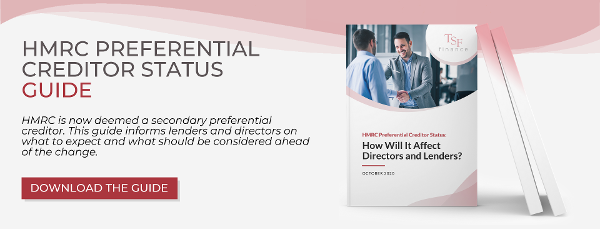For both company directors and finance lenders alike, the Finance Act 2020 has caused a variety of changes. The Act introduced several alterations, such as the 2% digital service tax. However, the biggest change was the move by the government to regain HMRC preferential creditor status.
That one change is proving to be very disruptive and having the government as a preferential creditor is going to have both long- and short-term consequences for a wide range of business models. Now that the Finance Act has come into effect, it will mean that when a business goes into insolvency, then HMRC will be ranked as the secondary preferential creditor, and that’s not good news for lenders or business owners.
The meaning of HMRC preferential creditor status
The policy change is intended to crack down on those companies that are avoiding their tax payments. The result for the treasury will be an estimated additional £185 million a year, but feedback for the shift to HMRC preferential creditor status has been largely negative. That’s because HMRC has no investment in a business. Previously, that meant that any outstanding taxes were at the back of the queue, with other creditors and lenders prioritised. The move to grant HMRC preferential creditor status puts lenders on the back foot, although employees are still ranked higher than HMRC.
.png?width=411&name=TSF%20newsletter%20images%20(2).png)
How this will affect lenders and banks
When lenders have provided money for a business that has been unable to stay afloat, lenders would be ranked higher in priority than the treasury. With HMRC preferential creditor status, which is no longer the case. The government will be paid before any lenders, making it harder for those banks and financial institutions to get returns on their funds. However, the two main negatives are:
● Reduced returns: Before the Finance Act 2020, if many lenders are owed money, any available cash from the failed business would be shared out equally. Now, HMRC preference insolvency means that the Treasury will get the bulk of that money, leaving significantly less for the lenders to share among themselves. The main concern here is the ripple effect that will disrupt entire supply chains, affecting those smaller lenders who are taking bigger risks.
● Increased lending risks: If the HMRC preferential creditor status means that the government takes precedence over secured creditors, then those lenders face a rapid loss of security value. Lenders will then likely reduce their approvals for financial support, meaning potentially fewer businesses receive the business loans that they need. That will also mean that the cost of a business loan is going likely to increase, as will the amount of research that a lender will have to carry out into a business tax situation.
Changes to asset-backed lending
At the moment, floating charge assets such as cash flow secured loans or inventory facilities are viewed as security for loans. Reductions will be a potential issue, which will lead to asset-backed lenders to potentially consider either withdrawing their finance options or, at the very least, reducing them significantly. However, fixed-charge creditors will remain ahead of HMRC when it comes to receiving funds owed.
How HMRC preferential creditor status affects directors and their businesses?
Options are going to be reduced with the introduction of the HMRC insolvency laws. Businesses suffering from financial distress will have far fewer options available to them when it comes to getting the finances that they need. Although the government claims that “only a small fraction” of money lent to UK business will be affected, there are fears that the entire UK economy will be impacted negatively. Less money will be being returned to lenders and creditors, which will make those lenders, including banks, far more reluctant to approve business loans. The negative effects will trickle down to SMEs, and only those with a stellar financial history or an asset that can be classed as fixed charge security will be likely to get loan approvals.
What should directors be doing now?
At TSF finance, we work with a wide range of lending partners who can identify and provide you with the financial solutions that you need. If your business is struggling financially or you would simply like more information, then download your guide to HMRC insolvency below to see what to expect from the shift to HMRC preferential creditor status.
With our exceptional customer support and 100% independence, which means you don’t pay a penny for our broker services; we simply get you in contact with the lenders that are most suited to your business. Contact us today to find out more.











